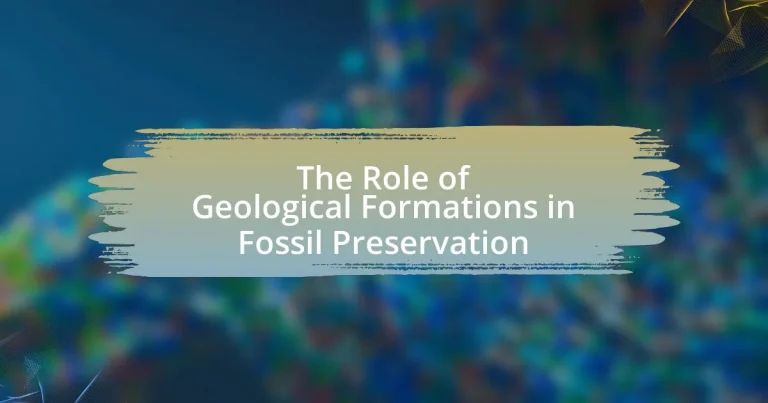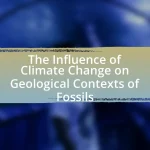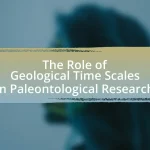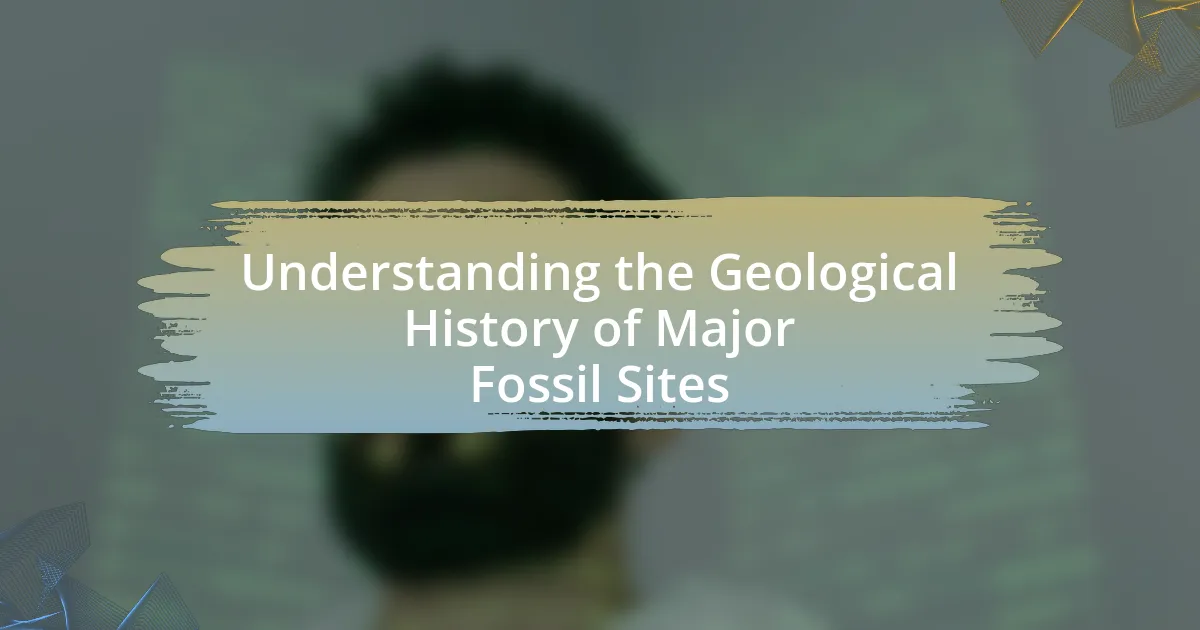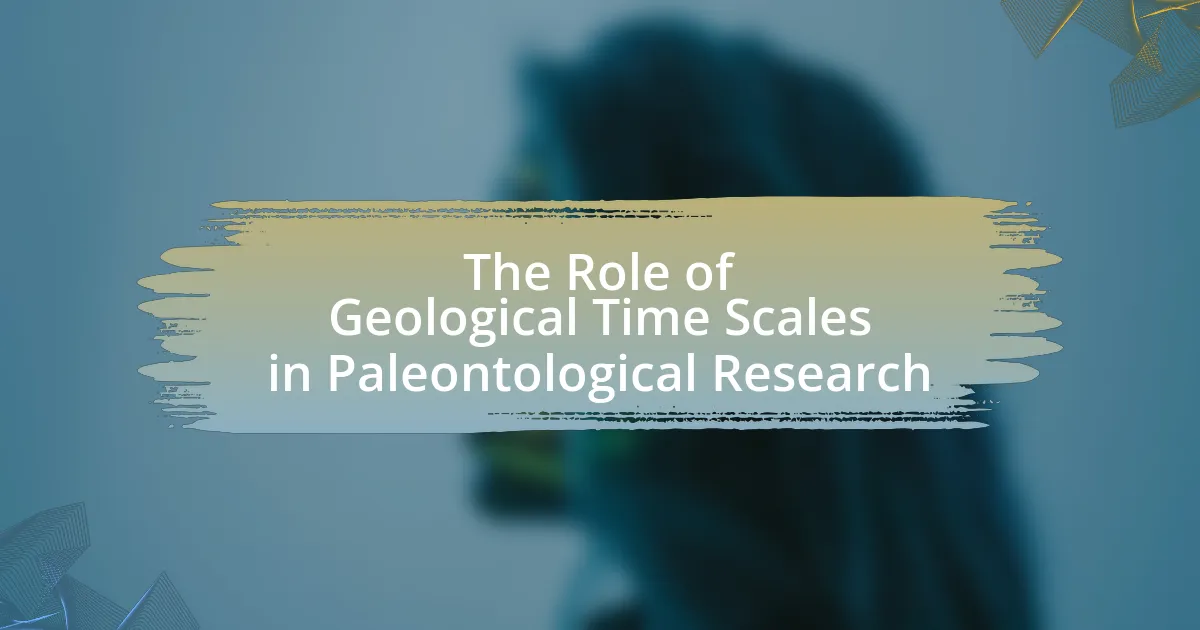Geological formations are essential for fossil preservation, providing the necessary conditions for the entombment and protection of organic remains. Sedimentary rocks, such as shale and limestone, create environments that inhibit decay and promote fossilization through processes like rapid burial and mineralization. Specific geological settings, including anoxic conditions and low-energy environments, enhance the likelihood of fossil preservation by limiting decomposition. The article explores the mechanisms of fossil preservation, the types of geological formations conducive to this process, and the environmental conditions that facilitate the preservation of various fossil types, ultimately highlighting the significant role geological formations play in understanding past life and ecosystems.
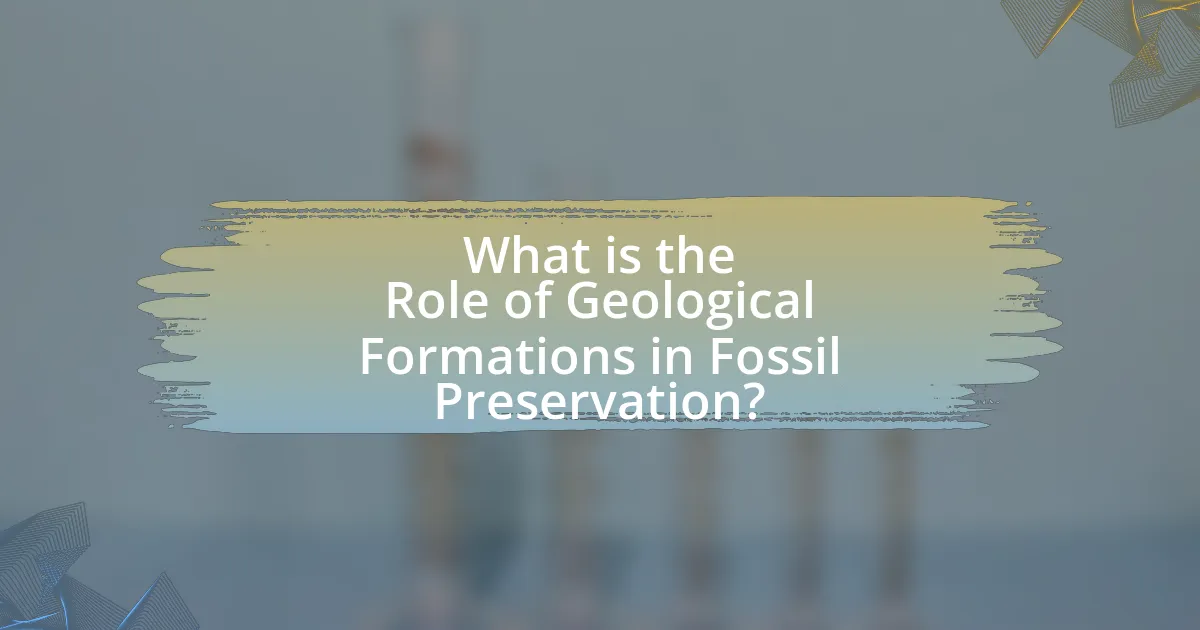
What is the Role of Geological Formations in Fossil Preservation?
Geological formations play a crucial role in fossil preservation by providing the necessary conditions for the entombment and protection of organic remains. These formations, such as sedimentary rocks, create environments that can inhibit decay and promote fossilization through processes like burial under layers of sediment, which protects remains from scavengers and environmental factors. For instance, the presence of fine-grained sediments can facilitate the formation of molds and casts, while anoxic conditions in certain geological settings can prevent the decomposition of organic material. Studies indicate that specific formations, like the Burgess Shale in Canada, are renowned for their exceptional fossil preservation due to unique depositional environments that favored the rapid burial of organisms.
How do geological formations contribute to the fossilization process?
Geological formations contribute to the fossilization process by providing the necessary conditions for the preservation of organic remains. These formations, such as sedimentary rocks, create environments where sediments can accumulate and cover biological materials, protecting them from decay and scavenging. For instance, rapid burial in sediment-rich environments, like river deltas or ocean floors, minimizes exposure to oxygen and biological activity, which are critical factors in decomposition. Additionally, the mineral composition of the surrounding sediments can facilitate the replacement of organic material with minerals, a process known as permineralization, which further aids in fossil preservation. Studies have shown that specific geological settings, such as anoxic conditions found in certain sedimentary basins, significantly enhance the likelihood of fossilization by limiting the breakdown of organic matter.
What types of geological formations are most conducive to fossil preservation?
Sedimentary rock formations are most conducive to fossil preservation. These formations, such as shale, limestone, and sandstone, provide the necessary conditions for the burial and protection of organic remains. The fine particles in sedimentary rocks allow for the gradual accumulation of sediments over time, which can encapsulate and protect fossils from decay and destruction. Additionally, environments like river deltas, lake beds, and ocean floors are particularly favorable for fossilization due to their low-energy conditions that promote sediment deposition and reduce disturbance.
How do sedimentary processes influence fossil preservation within geological formations?
Sedimentary processes significantly influence fossil preservation within geological formations by determining the conditions under which organic remains are buried and mineralized. Rapid sedimentation, for example, protects fossils from decay and scavenging by quickly covering them with layers of sediment, which can lead to better preservation. Additionally, the chemical composition of the sediment can facilitate the fossilization process through mineral replacement, where minerals in the sediment infiltrate the organic material, preserving its structure. Studies have shown that environments such as river deltas and lake beds, characterized by high sedimentation rates, yield a higher frequency of well-preserved fossils compared to areas with low sedimentation.
Why are certain geological formations more effective at preserving fossils than others?
Certain geological formations are more effective at preserving fossils due to their specific conditions, such as sediment type, burial depth, and environmental stability. For instance, fine-grained sediments like shale can encapsulate organic material more effectively than coarse sediments, which may allow for greater decomposition. Additionally, rapid burial in environments like river deltas or lake beds protects remains from scavengers and weathering, enhancing preservation. Geological formations that experience minimal tectonic activity also maintain the integrity of fossils, as excessive movement can distort or destroy them. These factors collectively contribute to the varying effectiveness of geological formations in fossil preservation.
What environmental conditions enhance fossil preservation in geological formations?
Anaerobic conditions, rapid burial, and low-energy environments enhance fossil preservation in geological formations. Anaerobic conditions limit decay by preventing the activity of decomposing organisms, while rapid burial protects remains from physical and biological disturbances. Low-energy environments, such as lagoons or deep-sea settings, reduce sediment disturbance, allowing for better preservation of organic material. These factors collectively create an ideal setting for fossilization, as evidenced by fossil-rich deposits found in sedimentary rock layers that exhibit these conditions.
How does the age of geological formations affect fossil preservation potential?
The age of geological formations significantly influences fossil preservation potential, as older formations often have undergone more geological processes that can enhance or diminish preservation. For instance, sedimentary rocks formed in stable environments tend to preserve fossils better than those formed in dynamic settings. Additionally, older formations may have experienced less disturbance, allowing for better fossil integrity. Research indicates that fossils in formations dating back hundreds of millions of years, such as those from the Cambrian period, often exhibit exceptional preservation due to the conditions of deposition and subsequent burial. In contrast, younger formations may be more susceptible to erosion and tectonic activity, which can compromise fossil integrity.
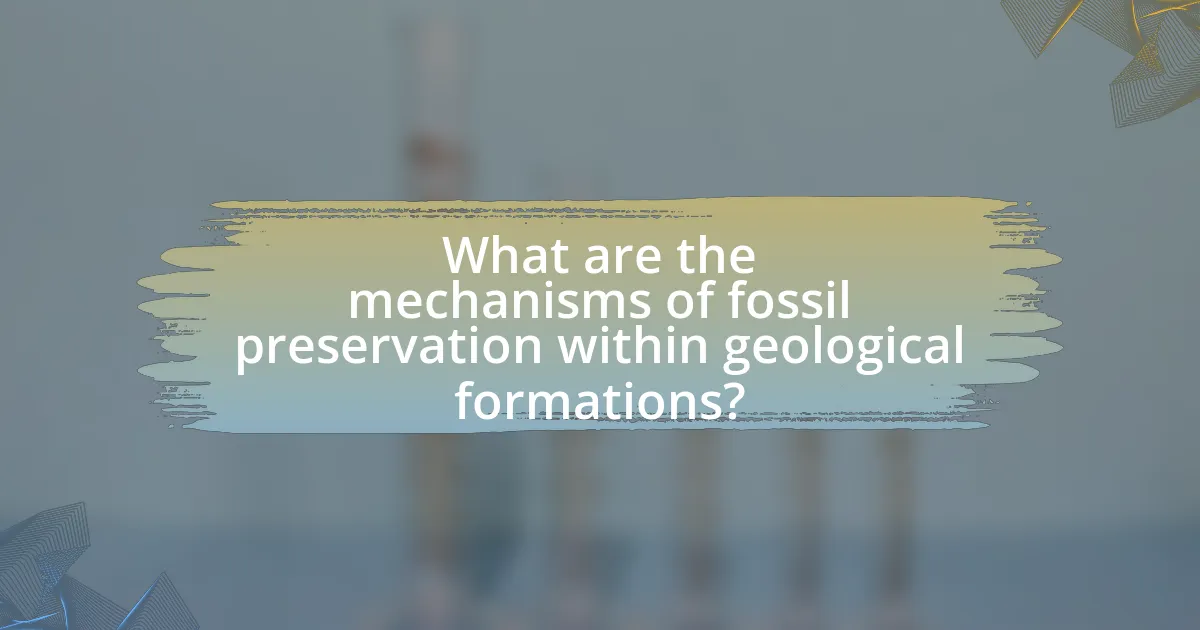
What are the mechanisms of fossil preservation within geological formations?
Fossil preservation within geological formations occurs primarily through mechanisms such as permineralization, cast and mold formation, and amber preservation. Permineralization involves the infiltration of mineral-rich water into organic material, leading to the hardening of tissues, as seen in many dinosaur bones. Cast and mold formation occurs when an organism leaves an impression in sediment, which later hardens, creating a mold, while minerals fill the mold to create a cast. Amber preservation captures organisms in tree resin, which hardens over time, preserving the organism in remarkable detail. These mechanisms are supported by geological evidence, such as fossilized remains found in sedimentary rock layers, which demonstrate the conditions necessary for fossilization.
How do mineralization and permineralization occur in geological contexts?
Mineralization occurs when organic material is replaced by minerals, while permineralization involves the deposition of minerals within the pores of organic remains. In geological contexts, mineralization typically happens in environments rich in minerals, such as sedimentary basins, where minerals precipitate from water and gradually replace the original organic material. Permineralization occurs when groundwater, saturated with minerals, infiltrates the remains of organisms, filling their cellular spaces and hardening over time, which is commonly observed in fossilized wood and bones. Evidence of these processes can be seen in fossil records, where detailed structures of the original organisms are preserved, demonstrating the effectiveness of mineralization and permineralization in fossil preservation.
What role do minerals play in the fossilization process?
Minerals play a crucial role in the fossilization process by facilitating the replacement of organic materials with inorganic substances. During fossilization, minerals such as silica, calcite, and iron can infiltrate the remains of organisms, gradually replacing the original organic material while preserving the structure and details of the organism. This process, known as permineralization, allows for the formation of fossils that can last for millions of years. Evidence of this can be seen in fossilized wood, where the original cellulose is replaced by silica, resulting in petrified wood that retains the original shape and texture.
How does the chemical composition of sediment influence fossil preservation?
The chemical composition of sediment significantly influences fossil preservation by affecting the conditions under which organic materials are buried and mineralized. Sediments rich in minerals such as silica or calcium carbonate can promote the rapid mineralization of organic remains, leading to better preservation. For instance, studies have shown that sediments with high clay content can create an anaerobic environment that slows down decomposition, thereby enhancing fossilization potential. Additionally, the presence of specific chemical compounds, like iron or sulfur, can lead to unique diagenetic processes that further stabilize fossils.
What types of fossils are commonly found in various geological formations?
Common types of fossils found in various geological formations include body fossils, trace fossils, and chemical fossils. Body fossils, such as bones, teeth, and shells, represent the physical remains of organisms and are often preserved in sedimentary rock formations like limestone and shale. Trace fossils, including footprints, burrows, and coprolites, provide evidence of the behavior and activities of organisms and are typically found in sedimentary environments where organisms interacted with their surroundings. Chemical fossils, or biomarkers, are organic compounds that indicate the presence of ancient life and can be identified in sedimentary rocks, particularly those formed in marine environments. These fossil types are crucial for understanding the history of life on Earth and are preserved under specific conditions that favor fossilization, such as rapid burial and low oxygen environments.
Which geological formations are known for specific fossil types?
The Burgess Shale is known for its exceptional preservation of Cambrian-era soft-bodied fossils, including early arthropods and other marine organisms. This geological formation, located in Canada, dates back approximately 508 million years and provides critical insights into early animal life due to its unique conditions that allowed for the preservation of delicate structures. Another significant formation is the La Brea Tar Pits in California, which is famous for its well-preserved Pleistocene fossils, including mammoths and saber-toothed cats, preserved in asphalt. The tar acted as a natural trap, capturing animals and preserving their remains over thousands of years. Additionally, the Hell Creek Formation in Montana is recognized for its rich deposits of Late Cretaceous dinosaur fossils, including Tyrannosaurus rex and Triceratops, providing vital information about the diversity and extinction of dinosaurs. Each of these formations is characterized by specific environmental conditions that facilitated the preservation of distinct fossil types, contributing to our understanding of prehistoric life.
How do fossil types vary based on the geological environment?
Fossil types vary significantly based on geological environments, as different conditions influence the preservation and formation of fossils. For instance, marine environments often yield well-preserved fossils of organisms like mollusks and corals due to rapid sedimentation and anoxic conditions that inhibit decay. In contrast, terrestrial environments may produce fossils of plants and land animals, but preservation is often less favorable due to exposure to oxygen and erosion. Additionally, specific geological formations, such as sedimentary rocks, are more conducive to fossilization compared to igneous or metamorphic rocks, which typically do not preserve fossils. This variation is supported by paleontological studies that demonstrate the correlation between fossil types and their respective depositional environments, highlighting the role of sediment type, water chemistry, and biological activity in fossil preservation.
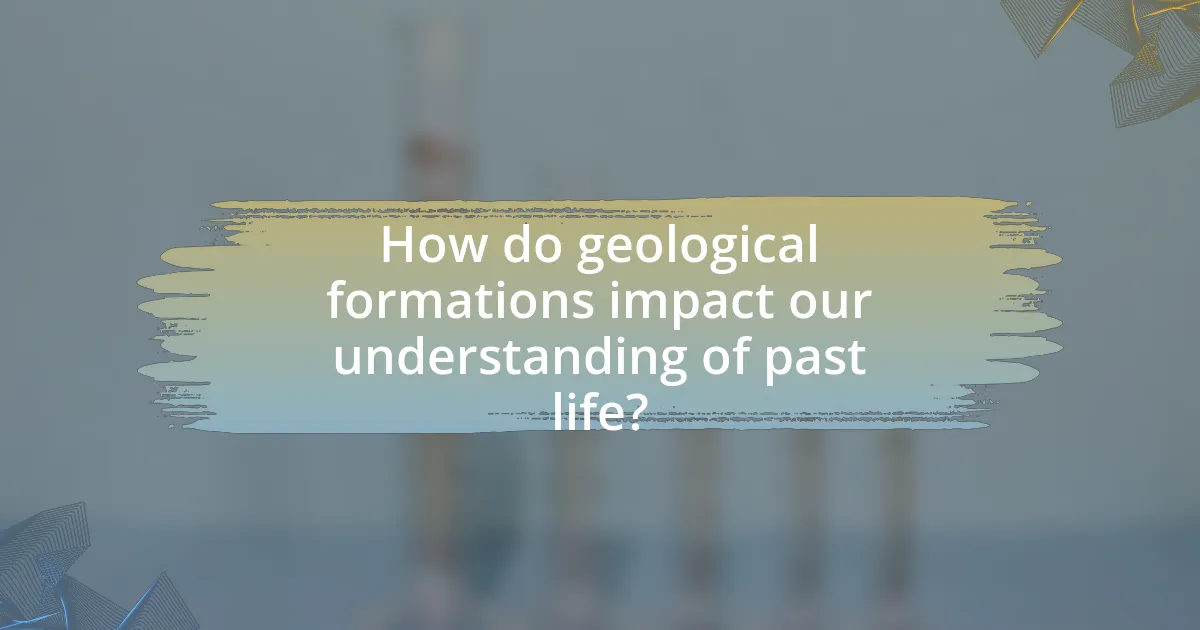
How do geological formations impact our understanding of past life?
Geological formations significantly impact our understanding of past life by providing the context in which fossils are found, revealing information about ancient environments and ecosystems. These formations, such as sedimentary rocks, often contain layers that correspond to different geological periods, allowing scientists to date fossils and understand the chronological sequence of life on Earth. For instance, the Burgess Shale formation in Canada is renowned for its well-preserved Cambrian fossils, which offer insights into early marine life and the evolution of complex organisms. Additionally, the composition and characteristics of these formations can indicate past climatic conditions, such as whether an area was once underwater or part of a desert, further informing our knowledge of how life adapted to changing environments.
What insights do geological formations provide about ancient ecosystems?
Geological formations provide critical insights into ancient ecosystems by preserving fossils and sedimentary structures that reflect past environmental conditions. These formations, such as sedimentary rocks, contain fossilized remains of plants and animals, which help reconstruct the biodiversity and ecological interactions of ancient life. For example, the presence of coal deposits indicates lush, swampy environments, while marine limestone suggests ancient oceanic conditions. Additionally, the stratification and composition of these formations reveal changes in climate and geography over time, allowing scientists to infer the dynamics of ancient ecosystems.
How can the study of geological formations reveal evolutionary trends?
The study of geological formations reveals evolutionary trends by analyzing the stratigraphic layers that contain fossils, which provide a chronological record of life on Earth. These layers indicate the types of organisms that existed at different geological periods, allowing scientists to trace changes in biodiversity, species adaptation, and extinction events over time. For example, the fossil record from the Burgess Shale formation in Canada shows a rapid diversification of life during the Cambrian period, highlighting significant evolutionary developments. Additionally, the presence of specific fossils in certain strata can correlate with environmental changes, such as climate shifts or geological events, further illustrating how organisms evolved in response to their surroundings.
What role do geological formations play in reconstructing paleoenvironments?
Geological formations are crucial in reconstructing paleoenvironments as they provide the physical context and evidence of past geological and biological processes. These formations contain sedimentary layers that reflect historical depositional environments, such as rivers, lakes, and oceans, which can be analyzed to infer climate conditions and ecological settings of the time. For instance, the presence of specific fossil assemblages within these layers can indicate the types of organisms that thrived in those environments, while isotopic analyses of minerals can reveal temperature and precipitation patterns. Such data allows scientists to piece together a comprehensive picture of Earth’s history, demonstrating how geological formations serve as archives of past life and environmental conditions.
What are the challenges in studying fossils within geological formations?
Studying fossils within geological formations presents several challenges, primarily due to the complexity of the geological context and the preservation conditions. Geological formations can vary significantly in age, composition, and structure, which complicates the identification and dating of fossils. For instance, sedimentary rocks, where most fossils are found, can undergo metamorphism or erosion, leading to the loss or alteration of fossil evidence. Additionally, the fossilization process itself is rare and requires specific conditions, such as rapid burial and low oxygen levels, making it difficult to find well-preserved specimens. Furthermore, the presence of diagenetic processes can alter the original biological material, complicating the analysis of fossil morphology and composition. These factors collectively hinder the accurate interpretation of the fossil record and the understanding of past life forms and ecosystems.
How do geological processes complicate fossil recovery and analysis?
Geological processes complicate fossil recovery and analysis by altering the original context and integrity of fossil deposits. For instance, tectonic activity can shift rock layers, causing fossils to become inaccessible or misaligned, which complicates their identification and dating. Additionally, erosion can remove surface layers, leading to the loss of fossils before they can be discovered. Sedimentation rates also affect fossil preservation; rapid sedimentation can bury fossils quickly, but it may also lead to poor preservation conditions, such as lack of oxygen, which can hinder fossilization. These factors demonstrate how geological dynamics directly impact the ability to recover and accurately analyze fossils.
What techniques are used to overcome challenges in fossil preservation studies?
Techniques used to overcome challenges in fossil preservation studies include the application of advanced imaging technologies, chemical stabilization methods, and controlled excavation practices. Advanced imaging technologies, such as X-ray computed tomography (CT) and scanning electron microscopy (SEM), allow researchers to visualize internal structures of fossils without damaging them, providing critical insights into their morphology and preservation state. Chemical stabilization methods, including the use of consolidants and adhesives, help to reinforce fragile specimens and prevent further degradation. Controlled excavation practices, such as stratigraphic excavation and careful sediment removal, minimize disturbance to fossilized remains, ensuring that contextual information is preserved. These techniques collectively enhance the quality and reliability of fossil preservation studies, as evidenced by their successful application in various paleontological research projects.
What best practices should be followed for fossil preservation in geological formations?
Best practices for fossil preservation in geological formations include minimizing disturbance to the site, ensuring proper documentation of the fossil’s context, and utilizing appropriate protective measures during excavation. Minimizing disturbance helps maintain the integrity of the surrounding sediment, which can provide crucial information about the fossil’s environment. Proper documentation involves recording the fossil’s location, orientation, and associated materials, which is essential for future research and understanding of the fossil’s significance. Protective measures, such as using plaster jackets or other materials, safeguard fossils from damage during transport and storage. These practices are supported by guidelines from paleontological organizations, emphasizing the importance of careful handling and thorough record-keeping in fossil preservation efforts.
